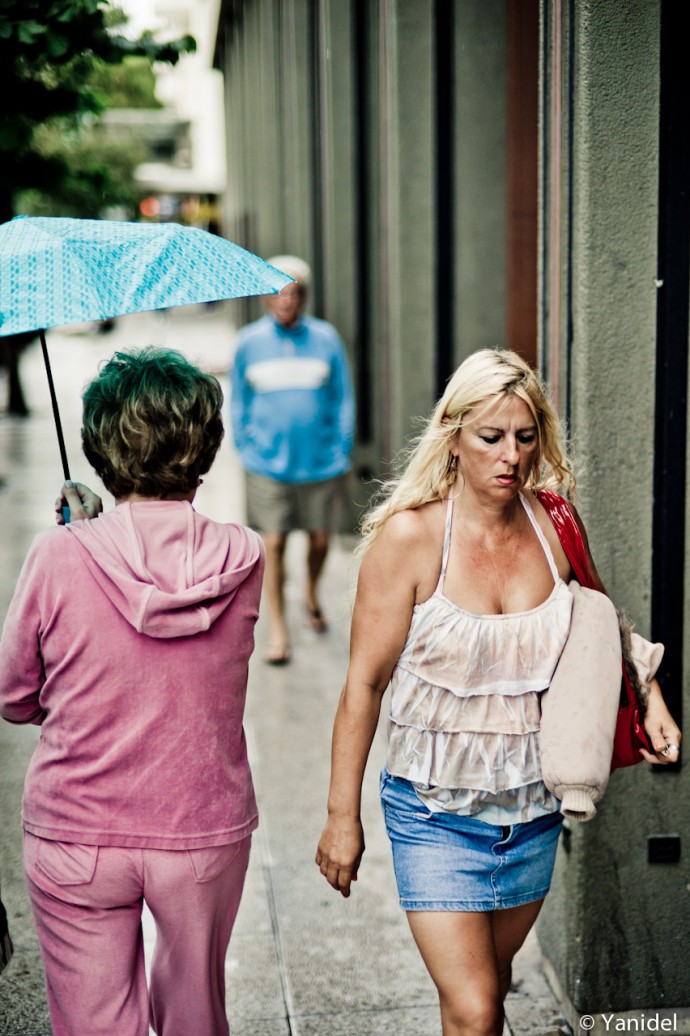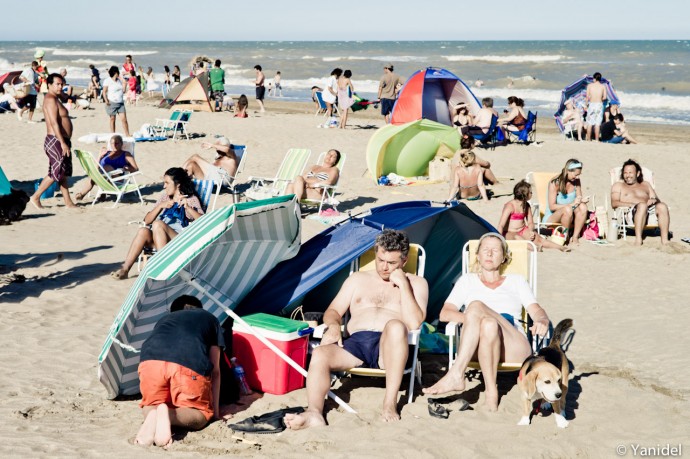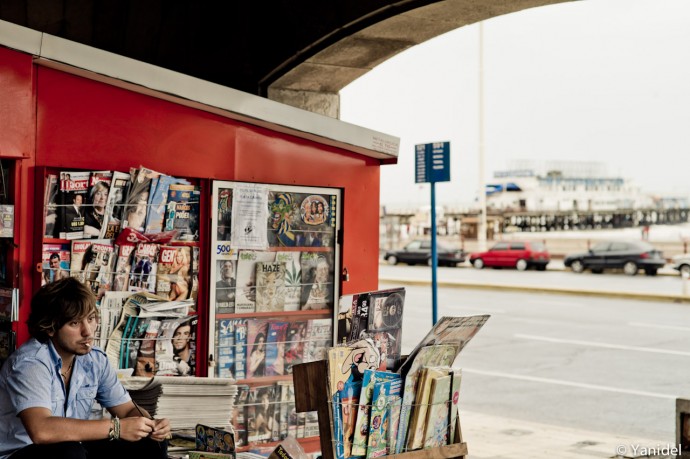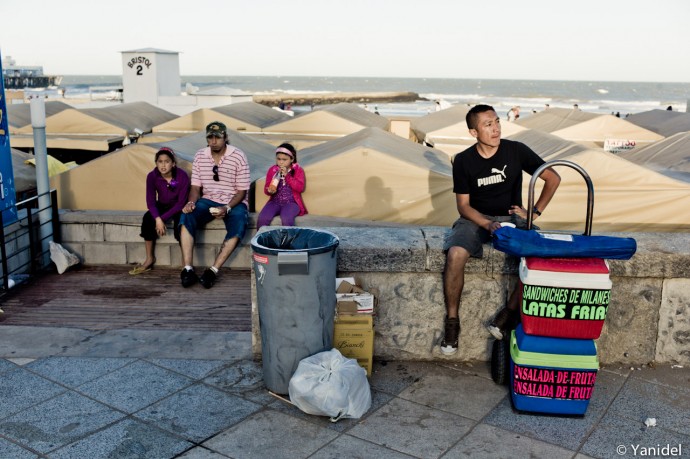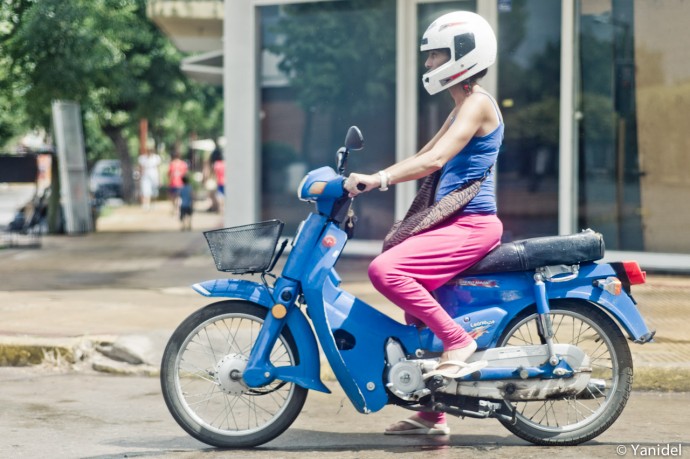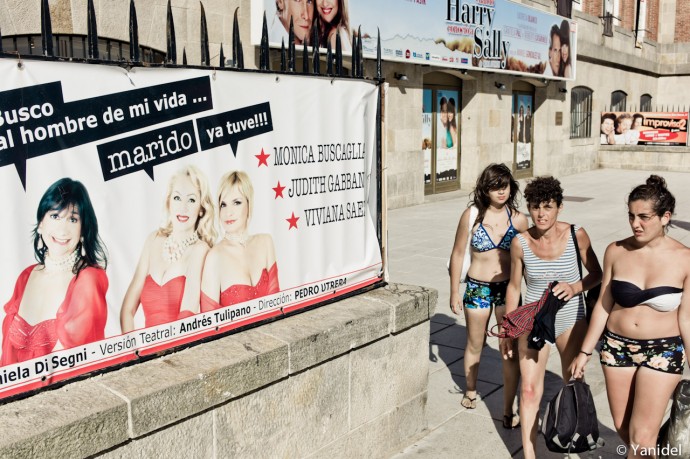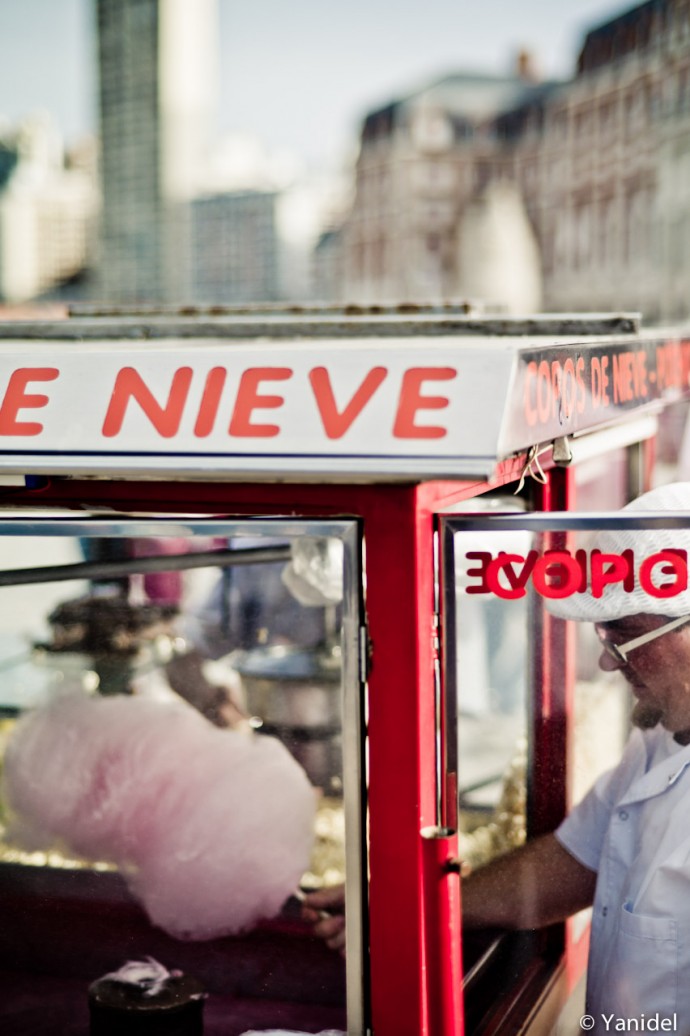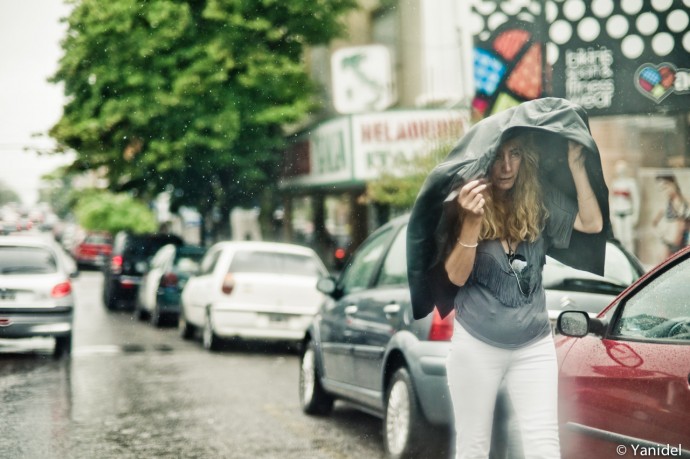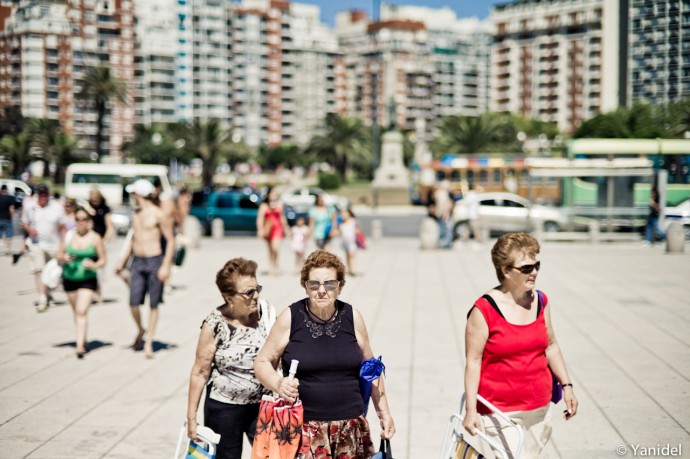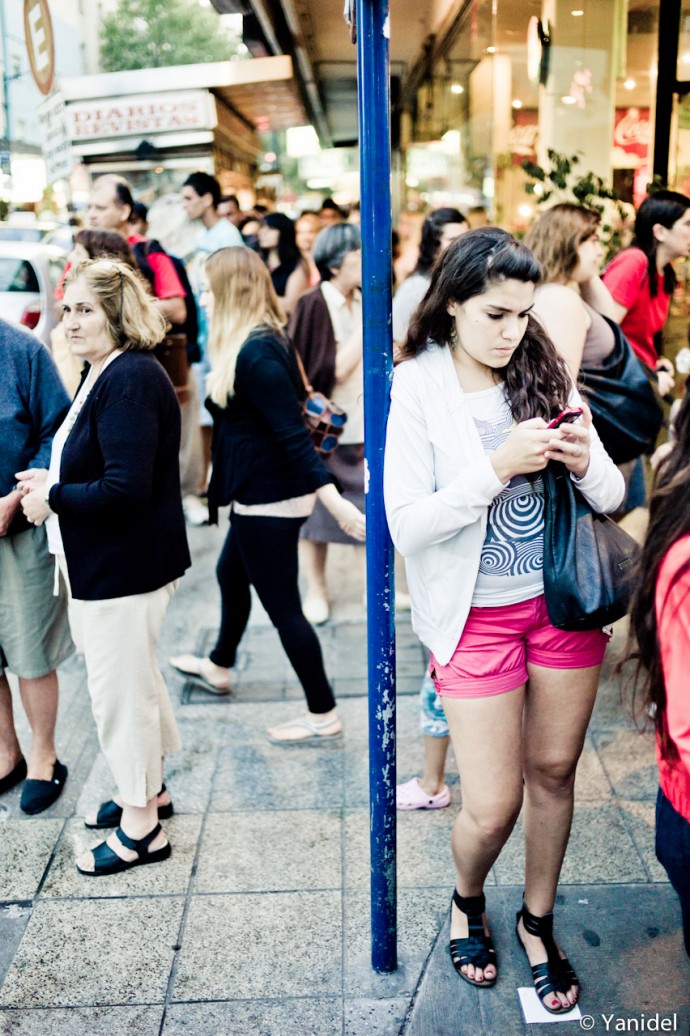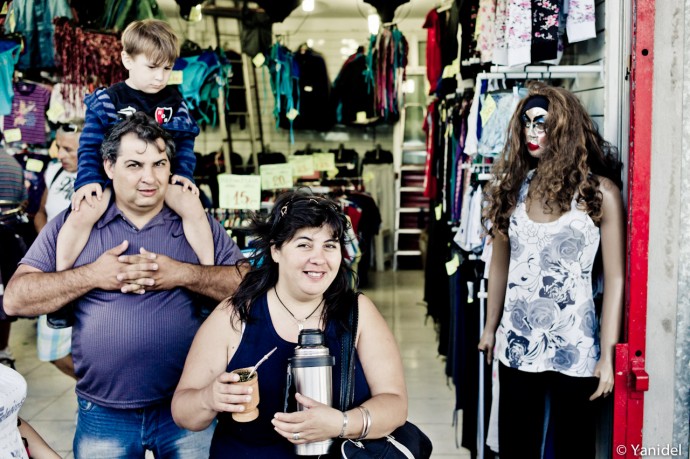A candid picture is in my opinion the ultimate goal in street photography. By candid, one means taking a shot where the presence of the photographer does not alter the scene. Indeed, people have a tendency to modify their behavior when they find themselves being photographed. Some will smile, others will look away, while most of the subjects will look at you in a puzzled way. Hopefully, there are some techniques to avoid this change of attitude, here are therefore 13 ways to shoot candids :
1) Shoot from behind
This is probably the most used technique by shy or beginner photographers. Obviously, since the person does not see you, its behavior won't be altered. Nevertheless, pictures from behind are rarely very interesting and often lame since the subject expression cannot be seen.
A good thing about this approach is that you can often include people passing by the subject at the moment you click. Indeed, in many case your subject will hide you from the incoming traffic, as illustrated in the shot below.
Leica M9 with 60mm Hexanon at F1.4, 1/500, ISO160
2) Focus and reframe.
I use this technique mainly when I am in front of my subject and there is a high probability to be spotted. I will therefore aim at about 45 degrees from by subject to give the impression I am shooting something else. When my focus is set, I will reframe very quickly and shoot straight away. Due to the small angle, I never actually lose eye contact with my subject so I can keep track of when the decisive moment is about to happen. The principal issue with that technique is when one shoots wide open, the pre-focus point must be at the same distance that your final subject, otherwise the shot will be mis-focused.
Before I hit the trigger on the shot below, I pre-focused on the pole holding the cotton candies at the right end of the picture (in the case of a rangefinder camera, the picture must be centered to do so). As the girl took a stance that I found interesting, I quickly reframed and snapped without her being aware of it.
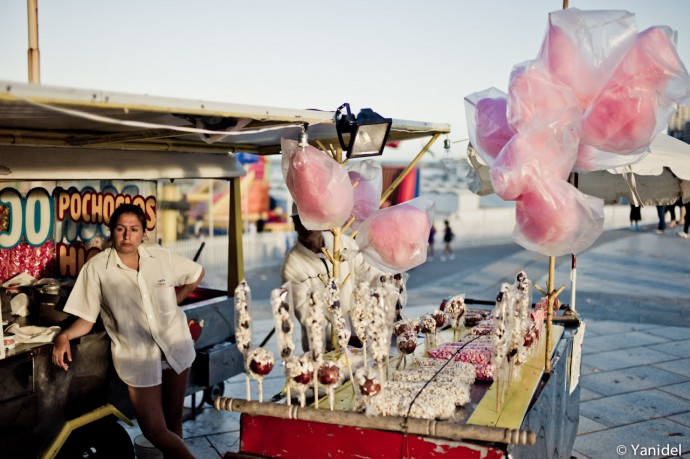 Leica M9 with 35mm Summilux Asph at F1.4, 1/2000, ISO160, ND filter
Leica M9 with 35mm Summilux Asph at F1.4, 1/2000, ISO160, ND filter
3) Act like your are filming a scene.
This one might seem silly but as you spot an interesting subject a few meters away, bring your camera to your eye and act like you are filming the scenery. For some reasons, people react less to someone filming than taking a picture with the lens pointed at them. In the picture below, I acted like I scanned 180 degrees of the beach. When my camera finally got in the field of view I had envisioned, I took the shot.
Leica M9 with 60mm Hexanon at F8, 1/250, ISO200, ND filter
4) Aim at a building or subject that is in the background of your subject.
This usually works quite well, provided of course that there is something significant in the background. If you are spotted, your subject will usually look at what is behind him. After he is convinced that your are not taking a picture of him, he will return to his normal behavior.
The scene thereafter illustrates this. Indeed, the newsstand boy initially thought I was aiming at him and altered his attitude. Then he looked back and saw the pier structure in the background so he stopped paying attention to me. After a minute or so, I finally could take the shot when I thought he had an interesting expression.
Leica M9 with 60mm Hexanon at F4.0, 1/180, ISO160
5) Crop
Not a very elegant one, but it can be effective with the recent high pixel count sensors. Indeed, take the shot from a distance where you won't be spotted, then crop to get a closer view. I personally hardly ever use it since I feel I am cheating. Nevertheless, there are sometimes instances where getting spotted could result dangerous so if you really want the shot, that will work.
Have a look at the two shots below. The initial one was taken from too far away so a crop resulted in a better framing. I must admit though that the reason I did not get closer what not in fear of getting spotted, but because my shadow started to appear in the middle of the picture.
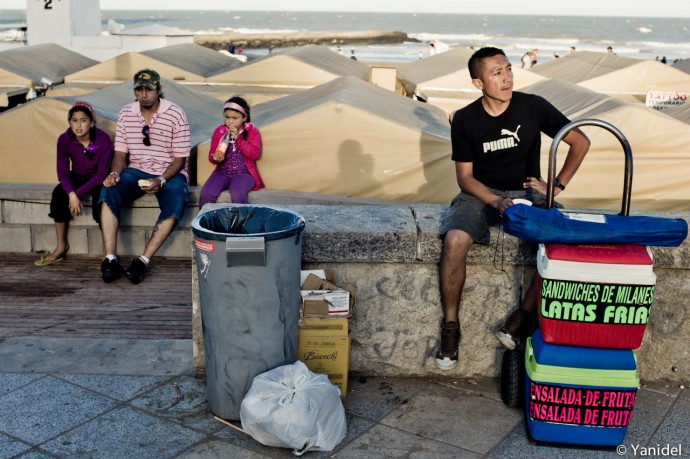 Leica M9 with 35mm Summilux Asph at F4.0, 1/250, ISO160
Leica M9 with 35mm Summilux Asph at F4.0, 1/250, ISO160
6) Use long lenses (or zooms)
A similar line of thought than the one above, shooting with long lenses will allow you to maintain some distance to your subject and avoid being spotted. With a rangefinder camera as the ones I use, your longest focal will probably be 90mm, maybe 135mm if you have good eyes. It is indeed quite effective for candid shots, yet mastering a 90mm lens or longer is not easy. First, depth of field is much thinner than a wide angle lens, so it will be difficult to have the whole frame in focus. For that same reason, it will be hard to get the desired focus point, especially when using fast lenses. Additionally, I often feel that many street shots taken with long lenses belong actually more to the portraits discipline than street photography. Indeed, it is not easy to include both a subject and its environment in such tight fields of view. This leads me to the final point, 35mm or 50mm lenses are versatile, you can shoot almost any situation with them. With a 90mm lens, it will be extremely difficult to shoot in all type of urban scenes, you'll have to be swapping lenses a lot (which does not apply if you use a zoom evidently). I took the shot below this morning with a 90mm lens to illustrate this article. I stood at about 5 meters and remained unspotted, yet the picture really stands more on the colors than the scene itself.
Leica M9 with 90mm Tele-Elmarit at F2.8, 1/3000, ISO200
7) Pre-frame and wait.
This is a way to shoot that I use quite a lot as I find it very effective in situations where you have identified a good potential setting, yet nothing is happening yet. The best way is too pre-frame and pre-focus and just wait for something to happen in your selected field of view. Moreover, if you wisely position yourself, you'll also be able to somewhat direct traffic to the point you want to.
In the picture below, I had spotted the show advertisement (which translates to "Looking for the man of my life, I already have a husband") and waited a few minutes for something worthy of interest to happen. I had placed myself on the right end of the sidewalk so people had to walk in front of me. When I saw the three girls walking towards my field of view, I brought the camera to my eyes, let them enter my frame and clicked. A second later, they attitude changed and they giggled.
This way to proceed is not without its disadvantages as many people will either bow their head or try to avoid you, yet with some patience you'll get the shot.
Leica M9 with 35mm Summilux Asph at F8.0, 1/250, ISO200
8) "Crawl in."
People usually spot you for three reasons :
– you invade their virtual private space. That space varies depending on the environment. In a crowded street, I'd say 2 meters while on parks and deserted streets it probably widens to 5 meters or so.
– you act in a strange manner. A perfect example of it is when one stops abruptly and raises its camera to his eyes in a rush. This will get you spotted many times while if you slow down normally and raise smoothly the camera to take the shot, odds are bigger that you will get the candid shot.
– your appearance is uncommon. I am very tall so usually people look my way because of the mass coming towards them. Same would apply if you dressed all in pink, or even all in black.
One can more or less control points 2 and 3 by refining its looks and attitude (in my case, it will be though to become smaller …), yet the crawl in method is a good way to enter one's private space without being noticed. To do so, stop slowly at about 5 meters and look busy doing something. After a while, your subject will forget about you and you can slowly start to crawl towards him.
This is how I proceeded in the shot below. I walked very slowly towards that man that was busy making cotton candy until I got to the point I wanted. I then waited for an worthy expression and took the shot. Had I walked quickly toward him, he probably would have detected me straight away.
Leica M9 with 60mm Hexanon at F1.4, 1/4000, ISO160
9) Shoot from the hip.
A very effective way to get candids, yet also a great recipe for terrible composition. Let your camera hang from your neck at hips level and shoot discreetly when you spot an interesting scene. I know quite a few photographers that like to shoot from the hip, but as far as I know, my hips don't have eyes. I therefore have a hard time believing that one can visualize effectively the field of view without actually viewing it through the viewfinder. It might not matter if the aesthetics of a shot are not your main concern, but in my case, I like good compositions and sincerely, most of my hips shots are either bent, with a big open sky, or mis-focused. Many people do master this technique, but their composition will always be limited at (waist level) and not very accurate. A good reason to use it is when you could put yourself in a bad situation by being spotted, a so so shot is always better than no shot at all.
I took the shot below walking in a street of Mar del Plata. I spotted the scene too late to raise the camera to my eye. I therefore quickly zone focused and wished for the best. The resulting composition is as shaky as the camera shake itself (another disadvantage of this method).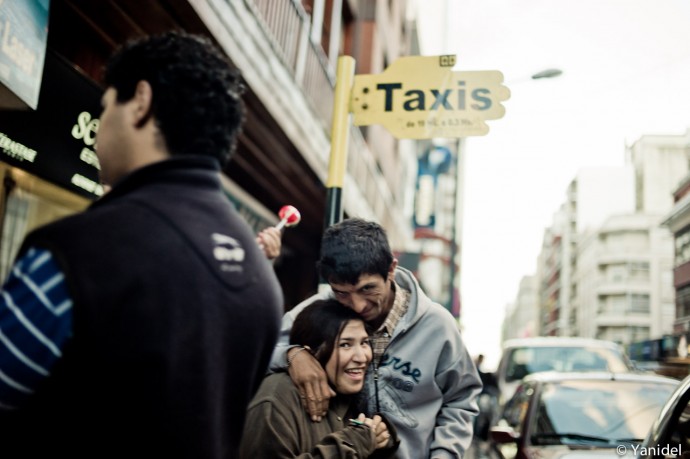
Leica M9 with 35mm Summilux Asph at F1.4, 1/350, ISO400
10) Behind a window
Sit behind a window at a bar or in a car. Most people will just walk by and never notice you. It is a great way to get candids though obviously quite limiting in terms of composition. Also, remember that using small apertures will make appear all the stains on your pictures and watch out for the many reflections (including your own) that might ruin your shot (or improve in some cases). Shooting from a car can also be fun, but very challenging in terms of composition and focusing.
In the midst of a rainstorm, the following shots was taken from the front seat of a car. Notice the slight halo effect on the pants of the woman. A bit artsy, but in fact, the result of condensation within the car.
Leica M9 with 60mm Hexanon at F2, 1/2000, ISO160
11) Shoot with the sun rays.
It's sunset and sun rays are hitting the passer-bys straight in the eyes. Great time for a few candids since people will never be able to detect you as the sun blinds them. I snapped the shot below early in the evening as a very bright sun reflected on the ground of Mar del Plata's casino court. The three woman walking towards me never spotted my camera, half blinded by the sun.
Leica M9 with 60mm Hexanon at F1.4, 1/4000, ISO160, ND filter
12) Head to a crowded area
A busy shopping street, a stadium surroundings, the metro, all are locations where people will pay less attention to you. They eyes will often be scanning all around but there is a good odd that you camera won't get noticed. And if you do get spotted, they'll probably won't come to the conclusion that you are shooting them, so they'll quickly retake their initial behavior. The following picture was shot in a busy shopping street of Mar del Plata. The girl notice my presence only after I took the picture.
Leica M9 with 35mm Summilux Asph at F1.4, 1/180, ISO400
13) Shoot faster than light.
The last technique is the most difficult. When the desired field of view means that you will get spotted no manner how you proceed, the only way to beat an alteration of your subject's attitude is to shoot very fast. It can be done, yet focus accuracy and camera shake will be a great challenge. Let me therefore end this series by a shot where this technique failed. Indeed, these sympathetic people were much faster at smiling then I was at focusing. Not too bad of an output in that case, but definitely not the shot I had envisioned.
Leica M9 with 60mm Hexanon at F4.0, 1/125, ISO160
Any other technique to suggest ? Do not hesitate to write about it in the comments section.
All pictures taken in Mar del Plata, Argentina
